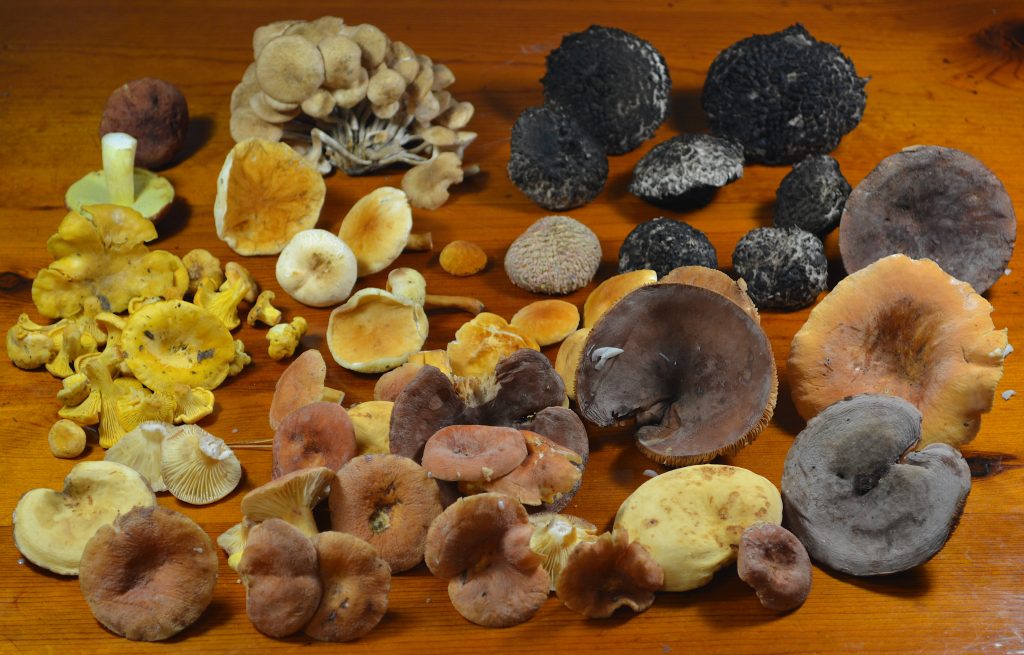
There are ten edible mushrooms species above, all collected locally. Photo by Green Deane
Unusual rains last week coaxed more life out of several edible mushroom species that were seasonally put to bed a month ago. Perhaps it’s Mother Nature’s trade off for starting the mushroom season about six weeks late this year.
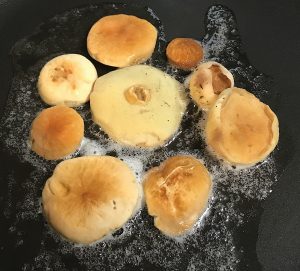
Frying Chestnut Boletes in Goat’s Butter. Photo by Green Deane
I created and moderate five mushroom pages on Facebook. One of them is quite large with over 5,000 members including several experts who are either published authors or academics or both. There were, however, two complaining posts recently that there is no website listing all the edible mushrooms in Florida with complete descriptions and photos. “Someone should do that” the writer said. That highlights two problems: One is the general reluctance these days to study, that is, the preference to rent information in your hand than own it in your head. The other is the impossibility of the task. No one knows how many mushroom species there are in Florida, how many of them are edible, and when you might find them as the seasons are changing (I have mentioned in previous newsletters.) And when you add getting photos of them… I personally know of 82 edible species of mushrooms in Florida — yes I have a list — and there are probably far more. Indeed, some think the entire group of Boletes in Florida are edible and the only reason not to eat them is you don’t like the taste or aroma. That’s a lot of mushrooms and perhaps some not even identified yet. Fungi can be so difficult that a little Marasmius that has been showing up in everyone’s lawn for about 15 years has yet to be identified and named despite academic inquiry and genetic testing.
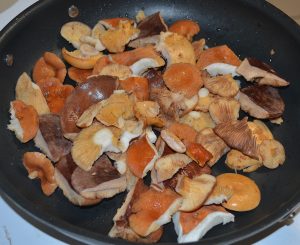
Torn “Milk Caps” ready for frying. Photo by Green Deane
All the mushrooms in the picture above are edible and were picked in two locations this past weekend. The ones on the bottom are mostly different Milk Caps (several don’t have common names.) The yellow ones on the left are famous for flavor and texture — Chanterellles — and are expensive when you buy them. The Chestnut-colored ones are plesant and the clumping ones above them are highly seasonal. The dark shaggy ones on the upper right have lovers and haters. They’re Old Man of the Woods and I really like them though the look nasty when cooked. The shaggy pink/gray one is bitter. There’s a little something for everyone there and all are fairly easy to identify. With the past rains we are now moving into our winter season. Most of the edibles from now to May or June grow on wood. There’s some fungus to find almost every month of the year. To read more about the one in season now— Ringless Honey Mushrooms — go here. The Facebook pages I moderate — besides EatTheWeeds and GreenDeane — are Florida Mushroom Identification Forum, Southeastern U.S. Mushroom Identification, Edible Mushrooms: Florida, Orlando Mushroom Group, and Edible Wild Mushrooms.
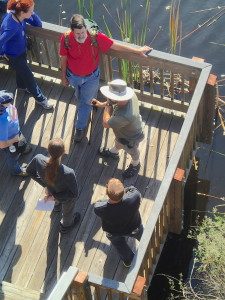
Foraging Classes are held rain or shine.
Foraging Classes this weekend are somewhat nostalgic. Saturday it’s John Chestnut Park in New Port Richey. It was my first teaching location in that area of the state. And Sunday we visit Mead Gardens in Winter Park for the first time in several years. It should be interesting.
Saturday Nov. 2nd, John Chestnut County Park: 2200 East Lake Road, Palm Harbor, FL 34685. 9 a.m. to noon. Meet at the beginning of the Peggy Park Trail inside the park.
Sunday, November 3rd, Mead Garden: 1500 S. Denning Dr., Winter Park, FL 32789. 9 a.m. to noon. Meet in the parking lot near the rest rooms.
Saturday November 9th Blanchard Park, 10501 Jay Blanchard Trail, Orlando, FL 32817. 9 a.m. to noon. Meet next to the tennis courts by the YMCA building.
Sunday, November 10th, Lake Woodruff National Wildlife Refuge, 2045 Mud Lake Road, DeLeon Springs, FL. 9 a.m. to noon. This class is rare because the federal property can be closed without notice. Meet at the first parking lot west of the railroad tracks.
Saturday, November 16th, Florida State College, south campus, 11901 Beach Blvd., Jacksonville, 32246. 9 a.m. to noon. We will meet at building “D” next to the administration parking lot.
Sunday, November 17th, Eagle Park Lake, 1800 Keene Road, Largo, FL 33771. 9 a.m. to noon. Meet at the pavilion by the dog park.
Saturday, November 23rd, Dreher Park, 1200 Southern Blvd., West Palm Beach, 33405. 9 a.m. to noon. Meet in the parking lot just north of the science center.
Sunday, November 24th, Bayshore Live Oak Park, Bayshore Drive. Port Charlotte. 9 a.m. to noon. Meet at the parking lot at the intersection of Bayshore Road and Ganyard Street. 9 a.m. to noon.
Saturday November 30th, Boulware Springs Park, 3420 SE 15th St., Gainesville, FL 32641. 9 a.m. to noon. Meet at the picnic tables next to the pump house.
For more information, to sign up for a class, or pre-pay go here.

My 24-hour watch stays on standard time 365 days a year.
This weekend the rude awakening returns: The time change, this Sunday. If you’ve read this newsletter for at least a half a year or wandered through the EatTheWeeds website you have read several rants about time change. In a sentence: I don’t do it. Why? Because it makes me ill for more than a week, as does travel. If I visit relatives in Greece — eight hours differences — I go for six weeks because I am sick the first two weeks (and for two weeks when I return.) When I went to Japan, which is 12 hours different, I was truly miserable for a month so I stayed two years. Most of the world does not do the time change. Those of us who don’t seem to get along just fine not leaping forward or falling back. I won’t repeat my entire well-rehearsed rant but you can read about it here.
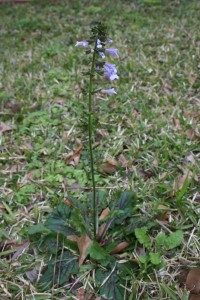
Lyre-Leaf Sage. Photo by Green Deane
In his book Edible Plants of North America, Francois Couplan writes on page 384: “the leaves of the S. lyrata, Eastern North America, contain an acrid principle and should not be ingested. They have been used to remove warts.” That said I know an herbalist who makes a tea from the leaves and a foraging instructor who cooks the young leaves and eats them. I’ve heard other reports of them being eaten. That can leave a person in a tough spot as to what to do with the plant. To eat or not to eat, that is the question.
Another related example is also a sage, Salvia coccinea, also known as Tropical Sage. A small piece of the blossom of this species — a very tiny piece, 1/8 inch square — made me horribly sick for several weeks. It attacked my stomach with viciousness and I was go-to-the-emergency room miserable. Coca-cola syrup and Pepto-Bismol combined were my salvation from doubled-over pain. I was actually “field testing” this plant for edibility at the time and one reason why I am very opposed to field testing. Yet, I know of two people who have eaten the young leaves with no problem. Perhaps it was a personal allergy on my part. I don’t know. But I do know I will never eat any part of that plant again. Ever. Lesson painfully learned. Yet it might be edible, or maybe some folks really do have cast iron stomachs. I know I don’t. I have a tender tummy. Eating this sage is one of those “you’re on your own” kind of things. My experience with the Tropical Sage is also why I avoid the blue Lyre-Leaf Sage.
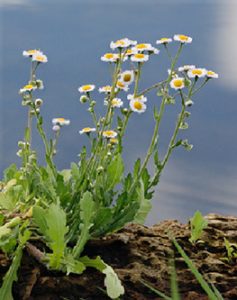
Oakleaf Flea Bane, good for pets’ beds.
Sometimes eating little bits of this or that do not rise to the level of making you ill. I know a person who mistook Oak Leaf Fleabane (Erigeron quercifolius) for for Plantago major and ate some for quite a while without an apparent problem. And I have personally seen someone eat a leaf of Oak Leaf Fleabane against my advice. She was still standing at the end of class. There are definitely edible plants and there are definitely non-edible plants. But there can be some fog in between. In last week’s newsletter we mentioned a local species of Richardia. It is generally considered not edible but some have mistaken it for Chickweed. One other mistake people make regarding wild plants is assuming if there is no acute toxicity (that is it makes you sick within a few minutes or hours) that it is edible. There are perhaps five species in Florida that will only make you sick if you eat them over time. Three damage the liver and two damage red blood cells. Those injuries take time to manifest themselves, days to months of consumption. Stick to the well-known edibles.
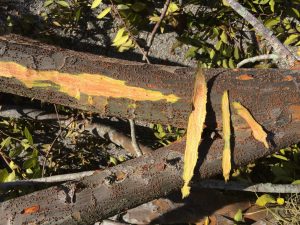
The cambium of many trees is edible. Photo by Green Deane.
A tree you see and don’t see that’s worth investigating is the Chinese Elm. It’s used in landscaping often. During the Great Depression of the 1930’s Chinese Elms were planted by the millions because it is resistant to the Dutch Elm Disease which wiped out most native elms in North America. The Chinese Elm is perhaps the most intentionally planted tree outside of the lumber industry. Young leaves, samaras, seeds and cambium are edible. Every tree’s cambium grows differently and is the “living” part of the tree. It grows in two directions at once, in and out. The inner cambium become the wood of the tree. The outer cambium becomes the bark of the tree. This gives each tree its distinct wood and bark. The bark on the Chinese Elm is part of its appeal and why it is also called the Lace Bark Elm. You can read about it here and watch a video here.
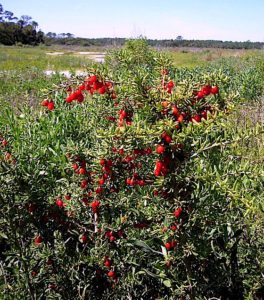 The seasons are changing and so is the foraging with a shift into not only fall but early winter plants. This locally includes some spring and summer plants found in northern climates. Perhaps the prettiest sighting will be Christmasberries. There are several “Christmasberries” but this one in particular is our local Goji Berry. It’s an odd shrub in the Nightshade family and likes brackish water. All the specimens I have found are coastal but usually on the inland water ways that have some tidal influence. They also tend to collect a lot of lichen often Ramlina and or Usnea. They weren’t blossoming two-weeks ago but were getting ready. I have found fruit as early as November. Keep your eye out. I have a video on them and and article here.
The seasons are changing and so is the foraging with a shift into not only fall but early winter plants. This locally includes some spring and summer plants found in northern climates. Perhaps the prettiest sighting will be Christmasberries. There are several “Christmasberries” but this one in particular is our local Goji Berry. It’s an odd shrub in the Nightshade family and likes brackish water. All the specimens I have found are coastal but usually on the inland water ways that have some tidal influence. They also tend to collect a lot of lichen often Ramlina and or Usnea. They weren’t blossoming two-weeks ago but were getting ready. I have found fruit as early as November. Keep your eye out. I have a video on them and and article here.
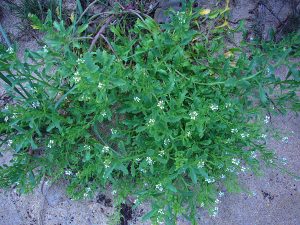
Like all mustards Sea Rocket has four-petal blossoms. Photo by Green Deane
Up north springtime means mustard time, here fall means mustards. The cooler weather brings them out. But not all mustards are the same. I could eat the large wild mustards back home raw. Not so here. I have to cook them or the tummy complains. But two locally that I like raw is our seaside mustards. We have two species of Cakile or Sea Rocket. They shows themselves in our winter and preferably on the beach above the rack line. You can also find them blossoming in coastal dunes. I have seen them once this year already. The leaves are a bit fleshy but as they are in a tough environment that helps them preserve water. While Sea Rocket can be found along most coasts of the United States, Maine to Washington State, Florida has its own variety, C. lancelolate. There is a video on them here and you can read more about them here.
 If anyone would like to donate to this website and newsletter they can use this Go Fund Me link, this PayPal donation link or by writing to Green Deane POB 941793 Maitland FL, 32794. My 9-DVD set of 135 foraging videos is still available — a green Christmas gift. You can learn more about that on the upper right hand corner of this page. And the Green Deane Forum is where we talk about foraging all year long. You can join that from the menu line at the top of this page.
If anyone would like to donate to this website and newsletter they can use this Go Fund Me link, this PayPal donation link or by writing to Green Deane POB 941793 Maitland FL, 32794. My 9-DVD set of 135 foraging videos is still available — a green Christmas gift. You can learn more about that on the upper right hand corner of this page. And the Green Deane Forum is where we talk about foraging all year long. You can join that from the menu line at the top of this page.
This is weekly newsletter 378. If you want to subscribe to this free newsletter you can find the sign-up form in the menu at the top of the page.

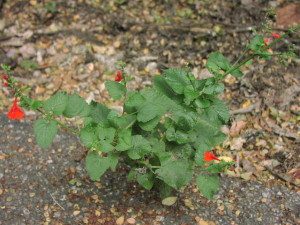

You prepare and write a very interesting newsletter. Thank you for that.
You may want to consider footnote article to your article on Chinese elm, so as to differentiate between two separate species of elm trees, often both species called Chinese elms. One is an excellent landscape tree. The other one, Ulmus pumila, is a terrible, terrible landscape tree. U. pumila is better called Siberian elm, which also was planted by the tens of thousands in the 1930s.
Incidentally, horses love to eat the cambium of the real Chinese elm, Ulmus parvifolia, which kills the tree.
Keep up your excellent work.
Ted Meredith
Clermont, GA
Oops! Just read your link and watched your video re Chinese elm. You cover info re both of the so-called Chinese elms. Dr. Michael Dirr regards U. pumila, the Siberian elm, as possibly the worst tree in the World.
Could not locate info in your newsletter edition re blue and red sages.
Ted
Oops, again! Just found and red your info re the blue and reds sages–Salvias.
Your photo shows you with a background of an apparent grass. In these areas, this grass or a similar one is sometimes referred to as broom sage or broom sedge. And of course, it is neither a sage or a sedge. It is also called “poverty grass” around here. I wonder if you talked about this grass in one of your newsletters.
Keep up your excellent work.
Ted
Clermont, GA
As far as I know broom sedge has not use other than to make brooms.